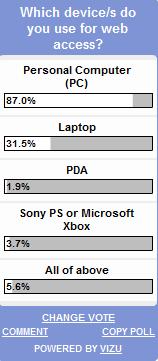As promised back in June, Internet Explorer 8 beta 2 has been released. Beta 1 showed promise, but true to its billing as a developer-only release, had a lot of rough edges and was painful to use for any prolonged period. This new beta is meant for everyone, and should be usable day-to-day. As well as a host of security, stability, and privacy features, the new IE has a raft of new features and user interface improvements that should make using the browser much more enjoyable. Suggestions and accelerators Launching IE8 for the first time after the (sadly) obligatory reboot, the browser asks the usual questions about default browsers, default search providers, and so on. As well as these typical questions, a couple of more unusual ones are asked. First of all, you're asked if you want to enable Suggested Sites, one of IE8's new features. This off-by-default option lets you discover sites that are similar to the ones you've already visited, based on which sites other people look at. The other new feature IE8 asks you about the first time it runs is "Accelerators." In beta 1 these were called "Activities"; along with the new name is a wider selection of third-party accelerators in five categories: blog, define, map, send/e-mail, and translate. The way these work is the same as in beta 1; translation, mapping, and definitions are shown in situ in little balloons allowing quick and unobtrusive access to the Accelerator features. Tabs IE7's major addition to the Internet Explorer browsing experience was to finally add tabs, years after competing browsers supported tabbed browsing. IE8 lets you quickly reopen the last few tabs that you closed, which, given the number of times I've closed the wrong tab by accident, is a godsend. Similarly, you can reopen every tab that was open when you last quit the browser. Neither of these features is unique to IE8, of course, but that doesn't make them any less welcome. One refinement I'd like to see is the option to automatically reopen the previous session's tabs as my "home page." What is new is IE8's new tab grouping feature. Whenever you open a link on a page in a new tab (whether by middle clicking, ctrl clicking, or right click, open in new tab) the current tab and the new tab both become colored to indicate that they are now part of a group. Any further tabs spawned from the group take on the same color. The grouped tabs can then be closed in a single action. Tabs can be dragged between groups to regroup them, or ungrouped completely. I can certainly see myself using this to clear up after epic Wikipedia sessions, although I would like to see a few more tab group features; for example, though you can close every tab in a group in one action, you can't close every tab except those in the current group. Redmond, start your photocopiers IE8 plays catch-up in other areas, too. The Address Bar replicates Firefox 3's Awesome Bar; no longer used just for typing in addresses, it searches your history and RSS feeds to provide alternative results. I like the presentation of results, but having gotten a taste of the feature, I want it to do more; I want it to show actual web search results (as it does in Google) and to also show me anything found in my system (much like the Vista Start Menu does). Searching for text within a web page highlights all matches simultaneously, which makes scanning pages for the word you're looking for much easier. There's also a new "Caret mode" for keyboard-based browsing. When Caret Mode is enabled, a caret (the blinking indicator to show where the keyboard cursor is) appears in the page and can be moved with the cursor and page navigation keys. This option may assist screen-readers used by the visually impaired, as the caret position is typically used by such software to determine which bit of the screen gets read. It's also far more convenient than using tab to jump between links. The execution isn't flawless, however; sometimes the caret gets stuck or jumps around randomly, I suspect as a result of the page's underlying HTML structure. The new InPrivate Browsing mode is another feature found in other browsers. Each InPrivate window has a clear indicator in the address bar, and the feature appears to work very much as advertised. Any activity performed within the InPrivate session is forgotten as soon as the window is closed. Standards As covered in the beta 1 review, a key feature of IE8 is its improved standards compliance. To recap, IE8 will use "quirks mode" for pages that are missing proper HTML version information, and will default to its new "standards" mode for pages that include the information. One of Microsoft's (not entirely unreasonable) concerns was that this would break many websites; many sites that enabled standards mode would actually break, because they were expecting standards mode to be nonstandard, as it was in IE7. In recognition of this problem, Microsoft has provided the ability to switch between IE8's true standards mode and IE7's fake standards mode. Beta 1 used an ugly button that we were assured was temporary, and indeed beta 2 no longer includes that button. Instead, whenever IE8 shows a page that's using IE8's true standards mode, an extra "broken page" button appears in the address bar. If a page appears broken using IE8 mode, clicking the broken page button switches to IE7 mode, which will often be sufficient to fix the page. IE8 also allows you to default to IE7 mode in three ways: you can add sites to a blacklist, you can use IE7 mode for all intranet sites, and as a last resort, you can revert to IE7 mode for all sites. I think this range of options is a pretty good compromise. More disappointing (although not IE8's fault as such) is just how broken many of Microsoft's own websites are when forced to use IE8 mode. Windows Live Mail, for example, is quite unusable in IE8 mode: I haven't obfuscated this picture to hide private information; that's how it actually appears. The Windows Live sites are due to be updated soon, so perhaps these issues will be fixed. Nonetheless, it would be nice if Microsoft would take a lead here; it will be difficult to convince third parties to update their sites for IE8 if the company cannot itself be bothered to do the same. Conclusion IE8 has me surprised. Internet Explorer has fallen a long way behind Safari, Opera, and Firefox. IE7 brought the much-needed tabs, but was still a long way behind the competing browsers. And honestly, even IE8 hasn't caught up with the competition. But it's a great deal closer than I thought it would be. The standards compliance is certainly still a big issue, and the reality is that IE8 still won't be nearly as good on that front as the other three major browsers. Nonetheless, as an overall package, IE8 is a far better product than its predecessor. A lot of its features have been copied, sure. But they're good features. They're worth copying, and I'm glad they've been copied, because they make IE8 much more usable. There are IE8-unique features too, and though I think they still need polish, I think that the tab groups and accelerators, in particular, are compelling additions to the browser experience. Beta 2 still has bugs; in my brief usage so far I've seen a number of pages that have appeared with pieces missing (though each time refreshing has restored the missing parts), and on a couple of occasions the browser froze for several seconds, but it's a beta; I wouldn't expect it to be bug-free. After using beta 2, I am now confident that Microsoft actually cares about creating a good web browser, and I haven't felt that way since the days of the browser war. My only worry now is that MS will once again lose interest in its browser; I hope not. Source: arstechnica

_14e30a.png)
_8126ce.png)

